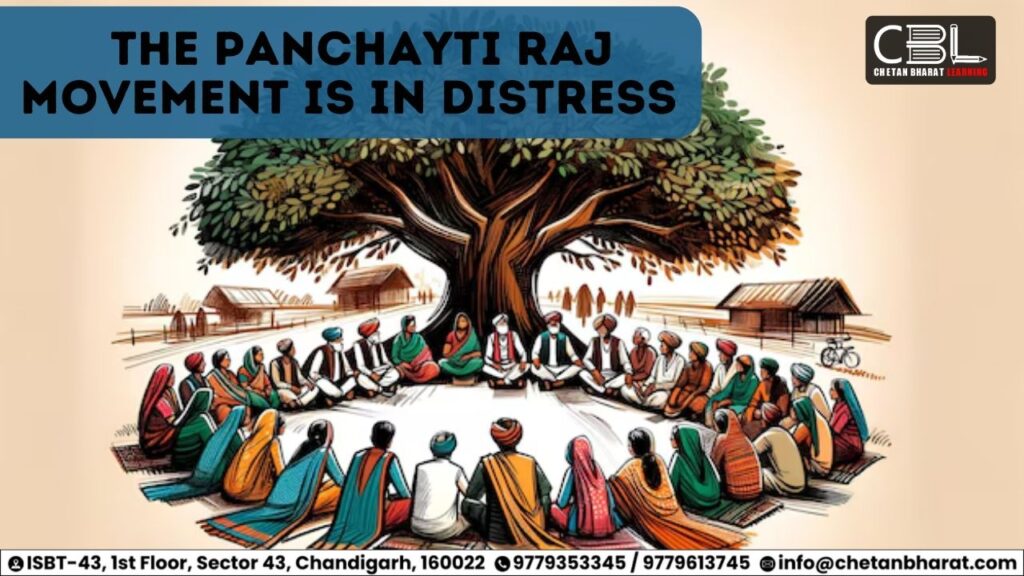
Important for UPSC, State PCS
Prelims: Panchayati Raj . 73rd Constitutional Amendment Act of 1992 .
Mains: General Studies Paper 2- Panchayati Raj Movement . Decentralization and Local Governance . democratic decentralization .
Context-
- The 73rd Amendment to the Indian Constitution, enacted in 1992, marked a transformative moment in India’s governance, introducing a decentralised system through panchayati raj institutions (PRIs).
- This amendment sought to bring democracy to the grassroots by establishing local self-government, ensuring representation, and empowering marginalised communities.
- However, despite its initial success, the panchayati raj system is currently facing a crisis due to systemic and policy-level challenges.
About the Panchayati Raj in India
- Historical Background: The concept of Panchayati Raj has its roots in ancient India, where village assemblies (Panchayats) played a crucial role in local governance.
- Mahatma Gandhi envisioned Panchayati Raj as the foundation of India’s political system, advocating for village self-governance (Gram Swaraj).
- The 73rd Constitutional Amendment Act of 1992 institutionalized this vision by creating a three-tier system of local governance:
- Gram Panchayat at the village level;
- Panchayat Samiti at the block level;
- Zila Parishad at the district level;
The Achievements of Panchayati Raj Institutions
- The panchayati raj system has made significant strides in democratising local governance.
- Elections to PRIs have become highly competitive, and political participation at the grassroots level has increased.
- One of the most notable achievements has been the empowerment of women in leadership roles, with nearly 14 lakh elected women representatives currently serving in panchayats.
- Furthermore, PRIs have played a crucial role in implementing various social sector programs, particularly in rural development initiatives.
- The Constitution mandated State Finance Commissions to allocate financial resources to local governments, ensuring that panchayats had the necessary funds to carry out their responsibilities.
- These achievements underscore the importance of panchayati raj institutions in developing inclusive and participatory governance.
- Despite these accomplishments, the panchayati raj system is facing a decline due to several structural and policy-related challenges.
Structure and Functioning of PRIs (As Per 73rd Amendment)
- The Panchayati Raj system operates through regular elections, held every five years, with reservations for women, SCs, and STs.
- It ensures inclusivity and representation of marginalized groups in local governance.
- The Gram Panchayat, as the basic unit of local administration, is responsible for implementing various development programs and schemes at the village level.
| Key Committees Related To Panchayati Raj Institutions – Balwant Rai Mehta Committee (1957): This landmark committee recommended the three-tier Panchayati Raj system, with Gram Panchayats (village level), Panchayat Samitis (block level), and Zilla Parishads (district level). – Ashok Mehta Committee (1977): Focused on strengthening financial resources and functional autonomy of Panchayats. – G.V.K. Rao Committee (1985): Emphasized the need for regular elections and greater participation of women and marginalized communities. – L.M. Singhvi Committee (1986): Recommended measures to address financial constraints and improve administrative efficiency of Panchayats. – P.K. Thungan Committee (1989): Proposed electoral reforms and devolution of more power and functions to Panchayats. – Natarajan Committee (1996): Assessed the implementation of the 73rd Amendment and recommended further devolution of power and resources. – Sachar Committee (2006): Highlighted the need for greater representation and empowerment of women in Panchayats. – M.V. Rajwade Committee (2017): Reviewed the functioning of Gram Sabhas and recommended steps to enhance their participation and effectiveness. |
Key Challenges
- Stagnation in Administrative Decentralisation
- While the initial phase of the panchayati raj movement saw significant progress in administrative devolution, momentum has since stalled.
- Effective local governance requires state governments to delegate administrative control and staff to PRIs, yet this has not been fully realised.
- A 2022 report by the Ministry of Panchayati Raj revealed that less than 20% of Indian states have transferred all 29 subjects listed in the Eleventh Schedule of the Constitution to local bodies.
- Without adequate administrative authority, panchayats struggle to function effectively.
- Erosion of Fiscal Autonomy
- Financial autonomy is crucial for effective local governance, but panchayats have increasingly become dependent on centrally sponsored schemes.
- While direct financial transfers to PRIs have increased over time, untied grants, which allow local governments to make independent decisions, have been significantly reduced.
- The proportion of untied grants dropped from 85% under the Thirteenth Finance Commission (2010–15) to 60% under the Fifteenth Finance Commission (2021–26).
- This reduction limits the flexibility of panchayats in addressing local issues, thereby weakening their decision-making power.
- The Changing Nature of Welfare Delivery
- Over the past decade, India has witnessed a shift in welfare delivery mechanisms.
- With the advent of digital financial systems like the Jan Dhan-Aadhaar-Mobile (JAM) platform, direct cash transfers have become a preferred method for implementing welfare schemes.
- While this approach enhances efficiency, it sidelines PRIs, reducing their role in beneficiary selection and grievance redressal.
- For instance, the Pradhan Mantri Kisan Samman Nidhi (PM-KISAN) scheme provides direct cash transfers to farmers, bypassing local governance structures.
- This shift diminishes the accountability and engagement that PRIs traditionally ensured in rural welfare programs.
- The Impact of Urbanisation
- India’s rapid urbanisation has also contributed to the declining relevance of PRIs.
- In 1990, nearly 75% of India’s population lived in rural areas; today, this figure has decreased to around 60% and continues to decline.
- As a result, policy priorities have increasingly shifted toward urban governance and municipal reforms, relegating rural development to the background.
- This demographic change threatens to marginalise PRIs, as attention and resources are increasingly directed toward cities and towns.
Revitalizing the Panchayati Raj System
- Strengthening Financial Autonomy: 15th Finance Commission has recommended increased funding for Panchayats, but timely allocation and effective utilization must be ensured.
- Panchayats should be given power to collect local taxes to reduce dependency on state and central grants.
- Enhancing Administrative Capacity: Proper training programs should be conducted for Panchayat representatives to improve governance.
- Use of digital governance tools can improve efficiency in fund management and service delivery.
- Reducing Political and Bureaucratic Interference: State governments must ensure greater autonomy for Panchayats by reducing bureaucratic control.
- Panchayat elections should be conducted fairly without political influence.
- Strengthening Social Audits and Accountability Mechanisms: Regular social audits should be mandated to reduce corruption and improve transparency.
- Gram Sabhas must be strengthened to allow active participation of villagers in governance.
- Women Empowerment in Panchayats: Strict laws should be enforced to prevent proxy representation in women-reserved seats.
- Leadership training programs should be provided to women representatives.
- Integration with Digital India and E-Governance: The use of e-Panchayat initiatives can enhance transparency and efficiency in governance.
- Digital literacy programs should be promoted in rural areas to improve citizen participation in governance.
Conclusion–
- The panchayati raj system was envisioned as a means to bring democracy closer to the people and empower local communities.
- However, systemic constraints, financial dependency, and shifting governance priorities have undermined its effectiveness.
- To ensure that PRIs remain relevant and impactful, India must adopt a renewed approach that prioritises administrative and fiscal decentralisation, integrates technological advancements, and redefines the role of panchayats in rural development.
- As 94 crore Indians still reside in villages, revitalizing the panchayati raj system is not just a necessity but a fundamental step toward inclusive governance and sustainable development.
CBL Practice Questions for Prelims –
Which of the following is explicitly mentioned in the 73rd Constitutional Amendment Act of 1992 regarding the Panchayati Raj Institutions (PRIs)?
A) Establishment of Panchayat Development Funds at the national level
B) Devolution of powers in relation to agriculture and rural development to the Panchayats
C) Representation of members of the Lok Sabha and Rajya Sabha in Panchayats
D) Minimum tenure of five years for Panchayats, and their non-dissolution before this period
Answer: D) Minimum tenure of five years for Panchayats, and their non-dissolution before this period
CBL Mains Practice Question
Analyze the significance of the 73rd Constitutional Amendment Act of 1992 in strengthening local self-governance in India. Discuss its impact on rural development.




Leave a Reply
You must be logged in to post a comment.